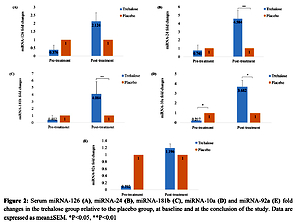Current issue
Archive
Manuscripts accepted
About the Journal
Editorial office
Editorial board
Section Editors
Abstracting and indexing
Subscription
Contact
Ethical standards and procedures
Most read articles
Instructions for authors
Article Processing Charge (APC)
Regulations of paying article processing charge (APC)
Editor's Choice
CARDIOLOGY / RESEARCH PAPER
Trehalose-induced alterations in serum expression levels of microRNAs associated with vascular inflammation in patients with coronary artery disease - the pilot results from the randomized controlled trial.
1
Department of Medical Biotechnology and Nanotechnology, Mashhad University of Medical Sciences, Mashhad, Iran., Iran
2
Immunology of Infectious Diseases Research Center, Research Institute of Basic Medical Sciences, Rafsanjan University of Medical Sciences, Rafsanjan, Iran, Iran
3
Department of Traditional Pharmacy, School of Pharmacy, Mashhad University of Medical Sciences, Mashhad, Iran, Iran
4
Targeted Drug Delivery Research Center, Pharmaceutical Technology Institute, Mashhad University of Medical Sciences, Mashhad, Iran, Iran
5
Research Department, Royal College of Surgeons in Ireland, Bahrain, Adliya, Bahrain, Bahrain
6
Department of Preventive Cardiology and Lipidology, Medical University of Lodz (MUL), Lodz, Poland
7
Mashhad Uni Med Sci, Iran
Submission date: 2022-08-08
Acceptance date: 2022-09-28
Online publication date: 2022-09-28
Corresponding author
KEYWORDS
TOPICS
ABSTRACT
Introduction:
Background: This study aimed to investigate the trehalose-induced alterations in serum expression levels of miRNAs associated with vascular inflammation in patients with coronary artery disease (CAD) in order to evaluate the effectiveness of intravenous (IV) trehalose administration in reducing arterial wall inflammation.
Material and methods:
Methods: This trial enrolled 14 men with a history of myocardial infarction (MI) and systemic inflammation. The patients were randomized in a 2:1 ratio to trehalose (15g/week, IV administration) (N=10) or placebo (equal volume 0.9% normal saline) (N=4) for a period of 12-weeks. The relative serum expression levels of miRNA-126, miRNA-24, miRNA-181b, miRNA-10a and miRNA-92a were assessed.
Results:
Results: IV trehalose administration significantly increased the serum level of miRNA-24 (2.473±0.72; P=0.037) compared to the baseline, but did not alter the other miRNA serum levels. However, at the end of the study, miRNA-24 (4.58±0.99; P=0.002), miRNA-181b (4.08±1.75; P=0.009) and miRNA-10a (3.68±0.63; P=0.013) showed notably higher serum levels in the trehalose relative to the placebo group. Furthermore, the reduction (normalized to baseline) in serum levels of miRNA-126 (P=0.042) and miRNA-92a (P=0.001) were reduced in the trehalose versus placebo group, while the serum level of miRNA-24 (P=0.007) was notably higher than that in the placebo group.
Conclusions:
Conclusion: Serum levels of miRNAs associated with vascular inflammation were altered following IV trehalose administration. The alterations in serum miRNAs, especially miRNA-126 and miRNA-24, could be considered as helpful biomarkers for the evaluation of trehalose potency in reducing arterial wall inflammation in patients with CAD.
Background: This study aimed to investigate the trehalose-induced alterations in serum expression levels of miRNAs associated with vascular inflammation in patients with coronary artery disease (CAD) in order to evaluate the effectiveness of intravenous (IV) trehalose administration in reducing arterial wall inflammation.
Material and methods:
Methods: This trial enrolled 14 men with a history of myocardial infarction (MI) and systemic inflammation. The patients were randomized in a 2:1 ratio to trehalose (15g/week, IV administration) (N=10) or placebo (equal volume 0.9% normal saline) (N=4) for a period of 12-weeks. The relative serum expression levels of miRNA-126, miRNA-24, miRNA-181b, miRNA-10a and miRNA-92a were assessed.
Results:
Results: IV trehalose administration significantly increased the serum level of miRNA-24 (2.473±0.72; P=0.037) compared to the baseline, but did not alter the other miRNA serum levels. However, at the end of the study, miRNA-24 (4.58±0.99; P=0.002), miRNA-181b (4.08±1.75; P=0.009) and miRNA-10a (3.68±0.63; P=0.013) showed notably higher serum levels in the trehalose relative to the placebo group. Furthermore, the reduction (normalized to baseline) in serum levels of miRNA-126 (P=0.042) and miRNA-92a (P=0.001) were reduced in the trehalose versus placebo group, while the serum level of miRNA-24 (P=0.007) was notably higher than that in the placebo group.
Conclusions:
Conclusion: Serum levels of miRNAs associated with vascular inflammation were altered following IV trehalose administration. The alterations in serum miRNAs, especially miRNA-126 and miRNA-24, could be considered as helpful biomarkers for the evaluation of trehalose potency in reducing arterial wall inflammation in patients with CAD.
Share
RELATED ARTICLE
We process personal data collected when visiting the website. The function of obtaining information about users and their behavior is carried out by voluntarily entered information in forms and saving cookies in end devices. Data, including cookies, are used to provide services, improve the user experience and to analyze the traffic in accordance with the Privacy policy. Data are also collected and processed by Google Analytics tool (more).
You can change cookies settings in your browser. Restricted use of cookies in the browser configuration may affect some functionalities of the website.
You can change cookies settings in your browser. Restricted use of cookies in the browser configuration may affect some functionalities of the website.



